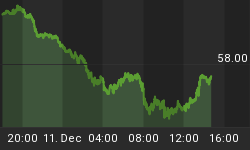How many gallons of water can one pump into a one gallon balloon? How high can one build a house of cards? In all such activities the laws of physics ultimately take control and dominate all else. Just as mankind can not repeal the laws of physics, it can not repeal the "Laws of Money." The Federal Reserve is aggressively attempting to defy the "Laws of Money," believing that it can stuff the money genie back in the bottle anytime it desires to do so.

The first chart is one at which we have looked before. It is the annualized 13-week rate of debt monetization by the U.S. Federal Reserve. Never in history of central banking has so much debt been monetized in such a short period of time. How will history judge this violation of the "Laws of Money?" What will be the ramifications of the U.S. Federal Reserve totally abandoning its independent role, becoming nothing more than the source of financing for the populism of the Obama Regime?
Ultimately, this massive debt monetization will have an impact on the value of the U.S. dollar. To argue otherwise is to repudiate all of monetary history. The inevitability of the depreciation of the U.S. dollar that will follow is not in dispute by any reasonable or objective observers. Ideologues now in power in the Obama Regime may argue otherwise. However, ideology does not trump reality.
In the halls of U.S. monetary policy, those making policy understand the consequences of their political surrender. They may deny it in their speeches and comments, but that does not change what will happen as a consequence of this debt monetization. When those policy makers are quizzed on the coming dollar depreciation some talk of taking action before that happens. They claim to be willing to "take the punch bowl away" in the nick of time.
Regrettably, that will not happen. The U.S. economy is now addicted to free money from the Federal Reserve. Any attempt to halt the debt monetization will send the U.S. economy again plummeting into the depths of the Obama Recession. And with the need of the Obama Regime to sell $2.4 trillion of debt in the next year, any talk of "taking the punch bowl away" is sheer folly, to use a polite word.

In our second chart, above, is plotted data at which we have looked before. This time it has been rearranged to give a forward-looking picture. The solid green line is the monthly average of U.S. $Gold price, and uses the right axis. Line of red circles is the inflationary component of U.S. money supply growth. For that we used an annualized six month rate of change. It is plotted versus the left axis. Additionally, it is advanced twelve months. The far right hand red dot is data for April 2009 but plotted as if it influences the $Gold price in April 2010.
Previously, we used the acceleration in U.S. monetary inflation to identify lows, or short-term bottoms, in the price of $Gold. In this chart we are attempting to use the peak rate of inflationary monetary growth to project out the price of $Gold. Each of the two previous highs in $Gold were associated with highs in inflationary U.S. monetary growth of twelve months before.
Were no other factors operating on $Gold, this chart suggests a low by September. It also suggests a new high that all of us would enjoy by this time next year. $Gold may be moving through the last great buying opportunity this Summer, assuming all other factors unchanged or the same.
However, not all factors are the same this year. Market impact of hedge funds has been materially reduced as so many have been eliminated. Others have had their market impact muted as less credit is available for them to inflate their assets.
Another difference today is that we now have the announcement that China had been buying some Gold. Interestingly, this news came as China began to more fully report to the IMF on reserve asset positions. What will be the ultimate impact of this announcement? Will the Chinese continue to buy? Will other central banks be encouraged to buy Gold? Will central banks be less willing to sell Gold knowing that the "big money" is buying? Is worrying about the IMF sales, whenever they might happen, unnecessary?

Well, how does Gold look to a Chinese investor? The above graph is of Gold denominated in Chinese Yuan. A lot of "clear sky" in that graph. Overhead resistance is non existent. Any move through the highs shown in that chart would put Chinese ¥Gold in a position to threaten all time high of about ¥7,200 that occurred a little over a year ago. Investors should probably quit focusing on the US$1,000 benchmark. It may no longer be relevant. The benchmark on which to focus may rather be ¥7,200.
Chinese people have one of the highest saving rates in the world. That high savings rate exists for a variety of reasons. Will Chinese savers respond to the news of the PNB buying Gold? How will Chinese investors respond to a new high in Chinese ¥Gold? And keep in mind, more wealth will be created in the next decade in China than has ever been created in any single decade. Investors need to now watch two Gold charts, one denominated in their home currency and one in Chinese Yuan. Remember, China is the wealth creator of this era and the Obama Regime is the wealth destroyer of today.
GOLD THOUGHTS come from Ned W. Schmidt,CFA,CEBS as part of a joyous mission to save investors from the financial abyss of paper assets. He is publisher of The Value View Gold Report, monthly, and Trading Thoughts, weekly. To receive these reports, go to http://home.att.net/~nwschmidt/Order_Gold_GETVVGR.html.
















